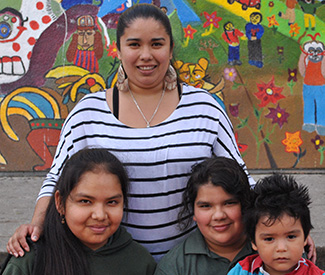
Oral Health Screening for All at Life Academy SBHC
Native American Health Center, Oakland
 Students in Oakland face harsh odds:
Students in Oakland face harsh odds:
- Homicide is the leading cause of death among youth;
- 26% of children are living in poverty; and
- 30% are dealing with depression-related feelings.
Given these overwhelming realities, clinic leaders knew that “selling” the importance of oral health to school administration and teachers might be a challenge.
Why would school leaders and teachers focus on dental screening when there are so many other difficult issues to address?
Framing oral health as an equity issue was the chosen approach, given that many of the school’s students had never even seen a dentist.
Screening During 9th Grade Clinic Visits at Fremont Tiger Clinic
La Clínica de la Raza, Oakland
Fremont High School is an urban public high school located in the Fruitvale District of East Oakland, California, and the school has had an onsite SBHC operated by La Clínica de la Raza for 21 years.
The Fremont Tiger Clinic is part of the school culture. Clinic staff wear school jerseys, participate in school events, and act as adult allies for students.
The SBHC is centrally located in the high school, allowing students more opportunity to drop in for small needs. The clinic has good recognition, and there is widespread belief that the SBHC is providing value to students.
Lessons Learned
Partnerships Are Key
Among the many lessons learned, the most important is the value of partnerships. Staff at Life Academy SBHC said this is true for school-based health in general, but shared that they learned it again and again with their oral health initiative. The collaboration with the NAHC dental department and with the UCSF dental and nursing students allowed the SBHC to reach greater numbers of youth and train new professionals in the value of oral health integration into school-based health. At Fremont Tiger Clinic building strong partnerships with school staff is a key priority because they control access to the classroom. Teachers and administrators can be important allies if they understand how the screening process improves access and ensures that poor health is not a barrier to learning.
Screenings Can Be Institutionalized & Increase Patient Engagement
The annual dental screening process has become significantly easier and is now part of the routine at Life Academy. While the grant has ended, the SBHC continues to do the annual screenings with great success. Students, teachers, and administration know what to expect and value the services being provided. While the very early planning stages of the dental screening required SBHC staff to figure out how to “sell” oral health, over time the dental screenings were appreciated and became a gateway to other SBHC services for students. At Fremont High, the screening drive has become routine at the school, and the patient population is steady as a result. Year after year, the screenings increase awareness about the clinic services and serve as a cost-effective approach to engaging more patients and building sustainability.
Schoolwide Screenings Provide an Opportunity for Health Career Exposure
One of the biggest surprises was youth interest in dentistry and health care as career options. During schoolwide screenings, youth were very curious not only about fluoride varnish but also about the people who applied it. As students were exposed to nurse practitioners in training, dentists, medical assistants, and physicians, the screening became an introduction to a variety of health professions. Life Academy for Health and Bioscience is a “health pathways” school and offers a unique class on becoming a medical assistant. After the screening, Life Academy added a component to their medical assistant class that focuses on oral health and fluoride application. The dental screening continues to inspire interest in dental and health careers.
This information is adapted from the Population-Wide Screenings in Schools Guide: A publication of UCSF and Family Health Together. We are grateful to our partners at ETR for funding and the UCSF School of Nursing for creating this content: Naomi Schapiro, RN, PhD, CPNP; Emily Green, RN, PhD; Victoria F. Keeton, PhD, RN, CPNP-PC; and Ivette Gutierrez, M.A.
We would also like to acknowledge Alameda County Center for Healthy Schools and Communities, Oakland Unified School District, La Clínica de la Raza, Native American Health Center, Lifelong Medical, Karen Gersten-Rothenberg, and Joanna Bauer for their contributions to this toolkit.
Photo credit: Randall Ann Homan



